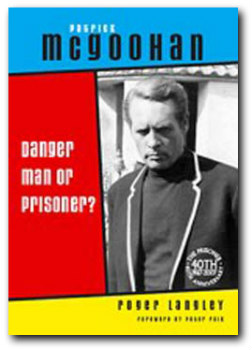
HOMEWesley Britton’s Books,
|
Spies on FilmSpies on Television & RadioSpies in History & LiteratureThe James Bond Files |
|
Spies on Film ~ Ice Station Zebra
– a tale of spies, scientists, and a submarine
By Roger Langley Editor’s Note ~ 
Episode 13 of the 1967-1968 British television series, The Prisoner, is of special interest for a number of reasons. Most importantly, the Vincent Tilsley script for “Do Not Forsake Me Oh My Darling” didn’t feature the show’s lead – New York born actor, director, and producer Patrick McGoohan. He only portrayed his character, Number Six, in introductory and concluding scenes. In between, Six was played by Nigel Stock in a mind-switching plot. The keepers of “The Village” had arranged the mind transfer to force Number Six to track down the inventor of the machine that made this possible. The reason for this concept was that McGoohan went out of the country to work in a film intended to be his major breakthrough in Hollywood – Ice Station Zebra. While his Everyman Productions company worked on “Do Not Forsake,” McGoohan joined major stars Rock Hudson and Ernest Borgnine along with former Cleveland Browns fullback Jim Brown to bring to life Alistair MacLean’s 1963 best-seller. Before this part, McGoohan had earned international recognition for his role as John Drake in the ITV produced Danger Man, known in the U.S. as Secret Agent, between 1965 and 1966. For Walt Disney, McGoohan had also been Dr. Christopher Syn in the miniseries, The Scarecrow of Romney Marsh. He’d been considered to play both James Bond and “The Saint.” But despite TV success and good reviews for his work in Ice Station Zebra, McGoohan never made the transition to a major star on the silver screen. Wondering why this was the case, SpywiseSecretDossier asked Roger Langley, author of the 2007 biography, Patrick McGoohan: Danger Man or Prisoner? (Tomahawk Press), if he had any thoughts on McGoohan’s work in Zebra. He graciously shared some photos from his collection and sent the following report. It’s but a glimmer into what he offers in his book, so SpywiseSecretDossier hopes readers will be intrigued enough to check out the newest contribution to explorations of the enigmatic Patrick McGoohan. Produced for the big screen by Marty Ransohoff, the original 1963 novel by Alistair MacLean was adapted by director John Sturges into a well-made combination of action and suspense, boasting a fine score by Michel Legrand. (His opening overture was restored for the 2005 DVD release.) The original theatrical release date was 23rd October, 1968, and in selected cinemas the movie was presented in 70mm Cinerama. Zebra was highly popular – nominated for two Academy Awards – but also gained notoriety from Howard Hughes’ obsessive, repeated viewing, declaring it his favourite movie. As Andrew Sumner said in his 2005 Uncut magazine review, Ice Station Zebra was “A Cold War thriller that relies on claustrophobic tension.” The story starred Rock Hudson as submarine USS Tigerfish commander James Ferraday. When a weather-monitoring station near the North Pole is nearly destroyed by fire, he’s ostensibly sent to find out what went wrong. But since he’s been ordered to bring along Capt. Leslie Anders (Jim Brown) and a platoon of Marines, British agent David Jones (Patrick McGoohan) and Russian defector Boris Vaslov (Ernest Borgnine), he realizes he’s being kept in the dark about the true nature of the mission. Eventually it becomes clear that the USS Tigerfish is in a race with a Russian sub to recover reconnaissance film crucial to national defence, being carried aboard a spacecraft which crashed near the polar ice cap. When the sub is sabotaged – causing it to sink perilously close to a depth that would lead to an explosion – it becomes clear that a double agent is on board, but Ferraday doesn’t have enough evidence to arrest anyone. 
Patrick McGoohan and Rock Hudson in a scene from Ice Station Zebra (1968). A central character interaction was between Hudson’s Ferraday and Patrick McGoohan’s Jones, who argue as to who has charge of the mission. Settling for an uneasy truce, Jones wants to commandeer the vessel, but Ferraday still commands it. In a defining scene in the Captain’s quarters, Jones slams a fist down on the table. When Ferraday matches the gesture, his is a more measured strike, showing the difference between them. Jones can react violently at any moment when so required, while the captain considers options and strategy.
In my book, I reveal some never before told stories about the production of Ice Station Zebra. Here’s one incident: In the making of one dramatic scene, McGoohan, or a stunt actor, was to dive and rescue a naval officer from a flooded torpedo room. Being a strong swimmer, the star chose to do the scene himself, although Olympic swimming champion Murray Rose accompanied him, in case anything went wrong. All went well, until the two men were up to their necks in rising water. Just before the “take,” McGoohan whispered, “Now I’ve done it. My foot’s stuck.” Rose dived and freed the actor’s foot – tightly wedged in a torpedo rack – in the nick of time. While the release of the film met with good reviews, the success of Zebra was not enough to propel McGoohan onto the Hollywood “A” list. The U.S. press, at the time of McGoohan’s “Tinseltown” debut, described him as “A six-foot, two-inch lance of a man with electric blue eyes and sandy hair. McGoohan is Britain’s highest paid television star, distinguished also as a stage actor who won ‘Best Actor’ award for his performance as Brand. But he dislikes the word star and says, ‘Call me an actor and I’m flattered. A star can be a mere personality. It takes work to become an actor.’” Roger Langley’s Patrick McGoohan: Danger Man or Prisoner? is available in bookstores everywhere, as well as these online merchants ~
|